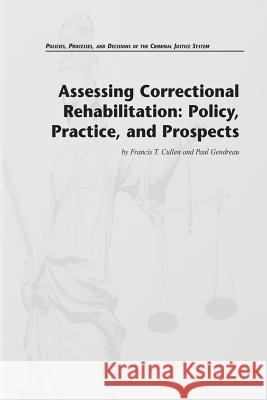Assessing Correctional Rehabilitation: Policy, Practice, and Prospects » książka
Assessing Correctional Rehabilitation: Policy, Practice, and Prospects
ISBN-13: 9781478262503 / Angielski / Miękka / 2012 / 68 str.
Assessing Correctional Rehabilitation: Policy, Practice, and Prospects
ISBN-13: 9781478262503 / Angielski / Miękka / 2012 / 68 str.
(netto: 57,76 VAT: 5%)
Najniższa cena z 30 dni: 60,15 zł
ok. 16-18 dni roboczych
Bez gwarancji dostawy przed świętami
Darmowa dostawa!
A theme that has persisted throughout the history of American corrections is that efforts should be made to reform offenders. In particular, at the beginning of the 1900s, the rehabilitative ideal was enthusiastically trumpeted and helped to direct the renovation of the correctional system (e.g., implementation of indeterminate sentencing, parole, probation, a separate juvenile justice system). For the next seven decades, offender treatment reigned as the dominant correctional philosophy. Then, in the early 1970s, rehabilitation suffered a precipitous reversal of fortune. The larger disruptions in American society in this era prompted a general critique of the "state run" criminal justice system. Rehabilitation was blamed by liberals for allowing the state to act coercively against offenders, and was blamed by conservatives for allowing the state to act leniently toward offenders. In this context, the death knell of rehabilitation was seemingly sounded by Robert Martinson's (1974b) influential "nothing works" essay, which reported that few treatment programs reduced recidivism. This review of evaluation studies gave legitimacy to the antitreatment sentiments of the day; it ostensibly "proved" what everyone "already knew" Rehabilitation did not work. In the subsequent quarter century, a growing revisionist movement has questioned Martinson's portrayal of the empirical status of the effectiveness of treatment interventions. Through painstaking literature reviews, these revisionist scholars have shown that many correctional treatment programs are effective in decreasing recidivism. More recently, they have undertaken more sophisticated quantitative syntheses of an increasing body of evaluation studies through a technique called "meta-analysis." These meta-analyses reveal that across evaluation studies, the recidivism rate is, on average, 10 percentage points lower for the treatment group than for the control group. However, this research has also suggested that some correctional interventions have no effect on offender criminality (e.g., punishment-oriented programs), while others achieve substantial reductions in recidivism (i.e., approximately 25 percent). This variation in program success has led to a search for those "principles" that distinguish effective treatment interventions from ineffective ones. There is theoretical and empirical support for the conclusion that the rehabilitation programs that achieve the greatest reductions in recidivism use cognitive-behavioral treatments, target known predictors of crime for change, and intervene mainly with high-risk offenders. "Multisystemic treatment" is a concrete example of an effective program that largely conforms to these principles. In the time ahead, it would appear prudent that correctional policy and practice be "evidence based." Knowledgeable about the extant research, policymakers would embrace the view that rehabilitation programs, informed by the principles of effective intervention, can "work" to reduce recidivism and thus can help foster public safety. By reaffirming rehabilitation, they would also be pursuing a policy that is consistent with public opinion research showing that Americans continue to believe that offender treatment should be an integral goal of the correctional system.
Zawartość książki może nie spełniać oczekiwań – reklamacje nie obejmują treści, która mogła nie być redakcyjnie ani merytorycznie opracowana.











